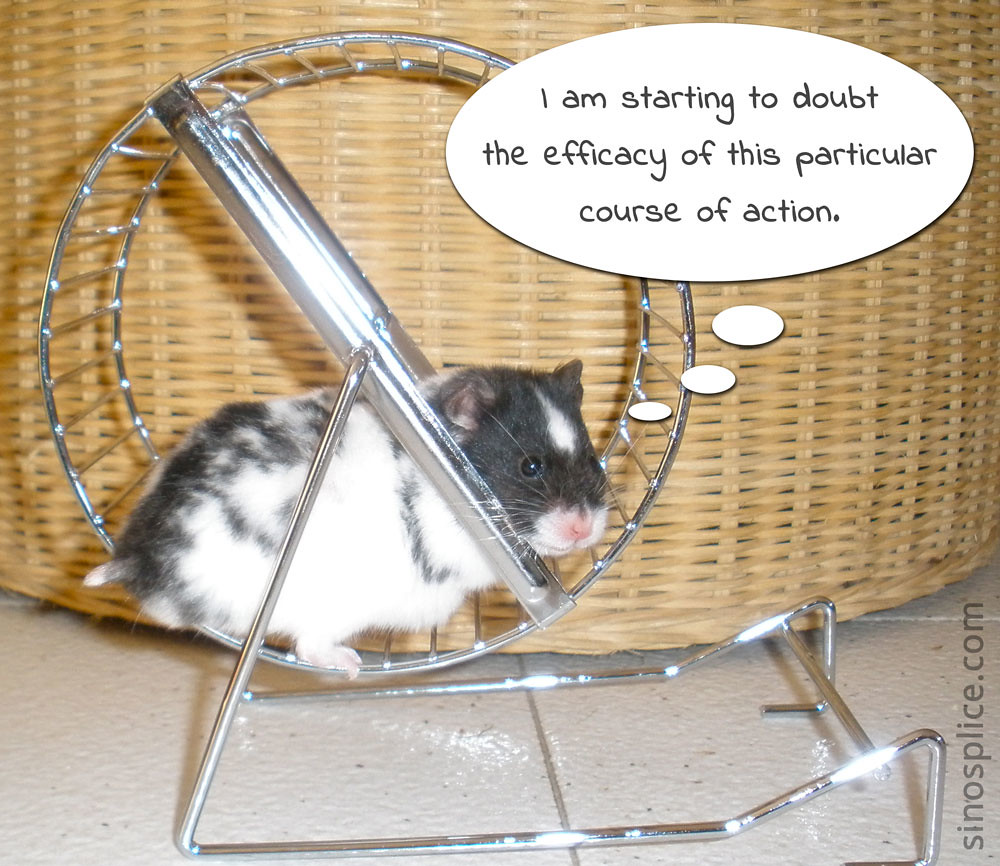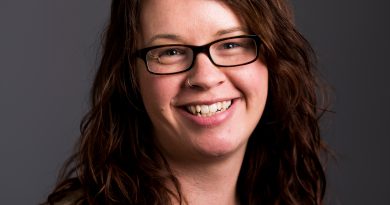
We Teach Humans, Not Content: Stepping off the Hamster Wheel
By Dana Grossman Leeman, Senior Associate Director, CELT & Annie Soisson, Director of CELT
In the spring of 2021, during the pandemic, I met with an instructor who was revising a course. As we looked at her syllabus, I noticed that the assigned readings for each week were numerous and totalled a lot of pages. As we perused the weekly session plans, I asked “where have you built in time for students to think about what they are learning, consider where it fits in with the overall arc of the course and actively apply it?” I suggested that the amount of content and reading might be overwhelming for students and I was concerned that it would not only increase their anxiety, but not lead to the desired outcome, which was for them to truly learn the material. And then she uttered the phrase so often voiced by faculty: “There is so much content to cover and simply not enough time to get through it all, much less create more activities that would eat up precious time.” Having taught for many years, I understood this tension. I often felt that I was running on a hamster wheel of content and if I let something go, reduced the reading load, lectured less and spent more time on application, I would fall off the wheel, which seemed disastrous. So, I ran and I ran.

A love of the material and a willingness to convey that to students only enhances learning. The problem occurs when the content matters more than anything else, faculty are prevented from using methods that enhance student learning.
Weimer, 2008
You might predict I will inevitably suggest that all instructors pare down the content in their class, cut the readings in half, or stop lecturing. Maybe. Those are certainly approaches you might consider, but please keep reading. If you are like many, if not most faculty, you are worried that any changes you make to your curriculum or pedagogy will in some way disadvantage your students as they progress on their educational pathway. These are reasonable concerns.
One of the tensions for faculty during the pandemic has been the fear of not covering everything, of making courses less rigorous if we reduce content. There is a substantial body of literature that addresses the inherent complexities and ineffectiveness of packing a course with content in a way that compromises learning (Weimer, 2014; DiCarlo, 2009). DiCarlo (2009) contends that “learning is not about committing a set of facts to memory, but the ability to use resources to find, evaluate, and apply information” (p. 258). Rigor, in fact, comes in the introduction of what Bjork (2019) called desirable difficulties, opportunities to try and fail and then try again, encounter learning in a new context or after a space of time. It is important to maintain high standards, not for memorization or performance, but for learning.
We Teach Humans, Not Content: Short Term and Long Term Memory
There are some evidence-based reasons you may want to reduce content in favor of active learning, peer work, and smaller, more frequent assessments. We can teach all of the content and assess student work, and students may even perform well in a course where there is a significant amount of content. However, there is a strong likelihood that students will not have learned it, and will have forgotten or seem to have forgotten much of it by the time they take the next course.
Most people are inaccurate in measuring their own knowledge, through judgments of learning, because they mistakenly rely on the immediate access to knowledge in order to determine the long-term memory retention and the transfer of such knowledge to different contexts
Learning and Forgetting Lab website, 2021
Are we as faculty inaccurate as well in our judgment of student learning, and deceived by plowing through content, assessing and moving on? Very likely so. Spaced and repeated retrieval practice are an important part of moving knowledge from short term into long term memory. Unless we strategically plan opportunities for students to wrestle with material and practice skills over time, we are not optimizing learning. This is one argument for reducing content, and prioritizing strategies that improve long term memory of the most important concepts and skills.
While we think of forgetting as a negative for learning, Bjork and Bjork, who run the Learning and Forgetting Lab at UCLA. Bjork’s research demonstrates that forgetting is inevitable and can actually be an important part of learning, and that performance is not equal to learning.
The distinction between “learning,” which can only be assessed at a delay, and “performance,” as indexed by the probability or speed of producing to-be-learned facts or skills during instruction or practice, is a time-honored distinction in research on learning, one that traces back to the 1930s.
Bjork and Bjork, 2019
Spending more class time in service of developing deep learning of the most essential learning objectives in your course in place of content might be a good trade off!
Choosing the Best Process for Learning, not Content Delivery
One question we like to ask in our Course Design Institute is “If you ran into a student in a coffee shop five years from now, what would you want them to tell you they remember from your course?” This can be a very enlightening and freeing exercise, and one that helps reframe the role of content. Monahan (2015) asserts that “With a shift in focus from covering content to using content, curriculum design also becomes less a matter of determining “what” to teach and more a matter of “how” to facilitate learning. A realignment of our role from content expert to content curator also puts content itself into a new perspective.”
As part of this new perspective you might ask the question “What is the best way for this content or skill to be learned?” Weimer (2008) describes this process of discernment:
“Marrying the content and the process [in teaching] requires an intimate and sophisticated knowledge of both. Some kinds of content are best taught by example, some by experience. Other kinds are best understood when discussed and worked on collaboratively. Other kinds need individual reflection and analysis. Besides these inherent demands of the content itself, there are the learning needs of individual students, which vary across many dimensions.”
Think of an idea as having a unique lifecycle. The student reads about a concept and then participates in a learning activity where they discuss the concept with others or practice it through an experiential activity (labs, simulations, role plays, debates, case/problem-based learning). The student reflects on the lessons learned to make meaning. . This process and the pedagogy that undergirds it are all directly related to the learning objectives of the course and reflect each other. Clear, reasonable, and achievable learning objectives allow you to develop learning activities and assessments to meet those objectives. And then decide on the necessary content.
Here are a few considerations to help you begin thinking about content and your teaching approaches for the coming academic year:
- Learning with understanding requires time. It is important to be realistic about the amount of time required to learn complex concepts (DiCarolo, 2009, p. 262).
- Think of yourself as a content curator, not just a content expert. As a curator, you can choose the best data sources, materials, and media for learning (Monahan, 2015; Weimer, 2014).
- Determine how much time students are spending on your reading and assignments. This article has guidelines for considering how much content to cover, the amount of assigned reading, and the amount of time estimated for different types of data sources. How Much Should We Assign? Estimating Out of Class Workload — Rice University Center for Teaching Excellence.
- More is not better. At the end of the day, what is most important to you? Is it more important that your students carefully read a bit less or skimmed more? The quality and variety of data sources will teach your students to critically evaluate the utility of resources and provide them with a diverse menu of resources from which to learn. They will become content curators as well. Is the reading you have assigned manageable? If it is dense, give them less of it so they have more time to do it (Monahan, 2015).
- Assign diverse resources that teach threshold concepts (Weimer, 2014). For example, supplement textbook readings with peer reviewed articles, blogs, TED Talks, or other instructional videos that demonstrate application. This is also an inclusive approach.
- Create time in your classroom for students to reflect on what they are learning as they learn it through metacognitive activities. These activities can be embedded into discussion (both in person and on discussion forums). Some great examples can be found here: https://resources.depaul.edu/teaching-commons/teaching-guides/learning-activities/Pages/activities-for-metacognition.aspx
- Connect their learning to their lives. This is an essential feature of adult learning. If students cannot see how threshold concepts matter to them as human beings, they are less likely to be learned. They can be memorized, but they may not be learned. There is a difference.
In what ways are you recalibrating your content to allow for deeper learning? Share your stories by emailing us at celt@tufts.edu.
References
- Forgetting as the friend of learning: implications for teaching and self-regulated learning | Advances in Physiology Education
- How Much Should We Assign? Estimating Out of Class Workload — Rice University Center for Teaching Excellence.
- Activities for Metacognition | Learning Activities | Teaching Guides | Teaching Commons | DePaul University, Chicago
- Research | Bjork Learning and Forgetting Lab
This is part 2 of a series to explore how many of our assumptions about learning were challenged, and in many cases transformed by those challenges during the pandemic. This post addresses the challenge of recalibrating how much content and which content is essential, and what it means for learning. To read other articles in the series, start with the introduction: Have We Been Transformed & How



